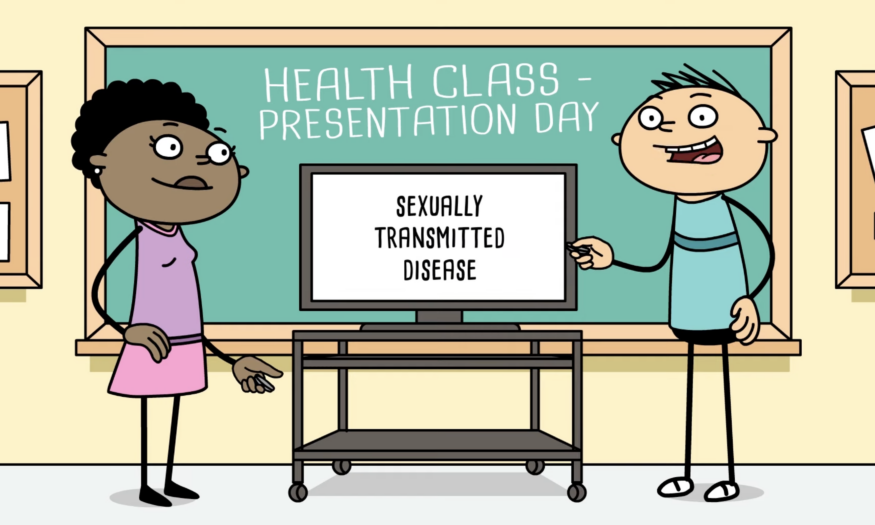Human Papillomavirus (HPV)

The following text uses the word “pussy*” as defined by Pussypedia.
by Caroline A
What is Going On?
What is HPV?
HPV is an abbreviation for an infection called Human Papillomavirus. It’s the most common sexually transmitted infection (STI) and it affects all genders and sexual orientations. At least half of sexually active people will get at least one HPV infection in their lifetime.1 If you and your pussy* are sexually active, you are likely to get HPV at some point, even if you don’t feel it, see it, or have any noticeable symptoms.2 Most people don’t even know they had it. According to the Center for Disease Control in the United States, “most HPV infections (9 out of 10,) go away by themselves within two years.”3
There are over 150 types of HPV virus out there today, and each type has a number.4 About 40% of those types are sexually transmitted and they infect different parts of bodies, like the vulva, vagina, cervix, rectum, anus, penis, scrotum, mouth, and throat.5
What Does HPV Look and Feel Like?
It is possible to get HPV, not know you have it, and have your body take care of it on its own, which happens quite frequently. So HPV might look and feel like nothing. HPV 6 and HPV 11 show in the form of warts on your genitals or more rarely, benign tumors on your throat but do not lead to cancer.6 But there are more than a dozen ‘high-risk’ types of HPV that you may not see or feel but that can lead to cancer.2 70% of cervical cancer cases come from type 16 and 18 in particular.7
How Do You Get HPV?
You get HPV during intimate sexual contact. Not just penetrative sex, but any kind of skin-to-skin sex play when your vulva, vagina, cervix, penis or anus touches someone else’s genitals, mouth, or throat.3 Many people have HPV, and most don’t display any symptoms so it’s easy to get HPV from a partner even if that person doesn’t realize they have it. Also, you can have HPV even if it has been years since you had sexual contact with the person who was infected.8
Things you DO NOT get HPV from:9
- Toilet seats
- Hugging or holding hands
- Swimming in pools or hot tubs
- Sharing food or utensils
- Being unclean
How Can I Take Care Of My Pussy*?
How Do You Prevent Getting HPV?
The most foolproof way of preventing HPV is really to avoid any sexual contact with another person. This means not just abstaining from vaginal, oral, or anal contact or sex, but it also means preventing those areas from touching someone else’s skin.10 Probably not a viable plan… But there are some good ways to lower your chances of getting or transmitting HPV to another person:
1. Get the HPV Vaccine (Vaccines help not harm!): Get the HPV vaccine (and tell your partner to get it too)! It’s for people with pussies* or penises. Everyone should get it, because even if a person has a penis, they can still carry HPV. If they get the vaccine, they are less likely to pass it to people with pussies*.7 If you get it before you have any sexual contact, it can provide nearly 100% protection against cervical pre-cancers and genital warts.3 The most recent version of the HPV vaccine, Gardasil 9, prevents against HPV types 6, 11, 16, 18, 31, 33, 45, 52, and 58, which include the most vicious, cancer causing strains of the virus.11
What If You Got an Earlier Version of Gardasil That Wasn’t the Newest Version, Gardasil 9?
A study from 2015 suggests, although not conclusively, that although earlier versions of Gardasil are “effective in protecting against four strains of HPV,” you might still benefit from getting Gardasil 9, which prevents against five additional strains/types. But researchers aren’t totally sure if you need an additional vaccine if you’ve already received Gardasil, and are still studying this question.12
What If You’re Older and Never Got the Vaccine As a Child Or As a Teenager?
Even if you didn’t get the vaccine early in life and have already been sexually active for years, it’s definitely still worth getting this series of shots. You might not yet be exposed to all types of HPV that are covered by the vaccine, and it’s possible to contract more than one type of HPV.3 In the United States for example, the Center for Disease Control explains that “since the first HPV vaccine was recommended in 2006, there has been a 64% reduction in vaccine-type HPV infections” among teens with pussies* in the United States.3 If you’re pregnant, talk to your doctor before you get this vaccine, because the vaccine hasn’t been adequately tested on pregnant persons.13
2. Use condoms and/or dental dams every time you take part in vaginal, anal, or oral sex.10 Although this method isn’t completely effective, safer sex can help lower your chances of getting HPV.14
How Can I Prevent Giving Someone HPV?
Get the HPV vaccine. Tell the person you’re going to hook up with that you have HPV. Practice safer sex.
Getting Tested
Get a pap smear regularly to test for cervical cancer and pre-cancers.
If you have a pussy*, and are between the ages of 21 and 29: your doctor will do a preliminary check to see if you have HPV during your annual pap smear exam by examining a swab of your cells. During this decade, you should have a pap smear every three years (at ages 21, 24, and 27). Since HPV normally clears up in younger people with pussies* on its own, doctors don’t specifically test for HPV in a routine pap smear in your 20s if your results come back as ‘normal.’ However, if your pap smear comes back with abnormal results, it can mean that you have a high-risk strain of HPV. Your doctor will call you to do a test that checks specifically for HPV and what type it is.15
If you have a pussy* and are between 30-65: your doctor can swab to test for HPV during your pap smear. This is called ‘co-testing.’ Most people have this co-testing done every 5 years, or do just a pap smear every three years. If you have a positive test, schedule another test for HPV in one year.16 It may go away on its own during that time, or grow slowly, so it’s okay to wait one year. If you have HPV and irregular cells in your pap, you may need further tests and treatment.
If you have a pussy* and are over 65 years of age: it’s not recommended that you test for HPV if you’ve had normal or negative test results and if you’ve had no precancers for the last ten years. In any case, your most recent pap test should be within the last five years. If you’ve had abnormal results in the past, or if you’re at high risk for cervical cancer, or if you’ve had a hysterectomy and don’t have a cervix, try to work with a doctor to form a testing plan that’s right for you.17
If you have a penis: it’s still very uncommon to be tested for HPV. There is no routine test to check for high risk HPV strains that can cause cancer. If you have genital warts, the doctor will examine them, but the test is not foolproof. If you notice any other abnormalities on your penis, anus, or mouth, go see your doctor. You can then be screened for high risk HPV. Finally, people with penises can be carriers, and never test positive for it. In fact, a study of people who identify as male between 18-59 years old showed that 25% of this group (also known as people with penises) may carry an aggressive strain of HPV, and that more than 45% of this group carry some strain of HPV. So, people with penises—yes, you should still get the vaccine.18
Treatments
If you have genital warts: it’s up to you to decide if you want to treat it. Your body’s immune system may get rid of them without treatment, but they can be uncomfortable and you can pass them to other people. If you are pregnant, your doctor or nurse can remove the warts so that they don’t complicate your delivery. Options for treating genital warts include chemicals administered on the warts, freezing the warts off, using a prescription cream yourself at home, burning the warts off at a clinic, or a Loop Electrosurgical Excision Procedure (LEEP), removing the warts with a knife or wire and electricity.19 These treatments remove the warts and lower your chances of passing the HPV infection to anyone else. Over-the-counter wart medicines to treat warts that are on your hands or feet should NOT be used to treat genital warts.
If you have a high risk type of HPV and your pap smear test is abnormal: your doctor will recommend further testing and treatment. Keep in mind that in the big scheme of things, all these further treatments are relatively minor, and moreover, very effective and safe.
You may get a colposcopy (kol-POS-kuh-pee): a very minor procedure where a gynecologist does a biopsy, which entails collecting some of your cells to closely examine your cervix, vagina, and vulva for signs of disease. If the colposcopy results show that your cells look normal, the treatment stops there.20
If the cells are shown to be precancerous, your gynecologist might suggest something called a LEEP or cryotherapy. Both of these treatments are regular office visits—you don’t stay overnight at a hospital. You can get them at your gynecologist, primary care doctor, or nurse’s office, and some community health clinics and centers. Talk to your doctor to find out a good location for you.21
Both the LEEP and cryotherapy remove abnormal cells from your cervix.22 In a cryotherapy treatment, a gynecologist or nurse puts very cold chemicals on the cells to freeze and remove them so that new, normal cells can grow in the same spot.23
In a LEEP, your gynecologist uses a small electrical wire loop to remove abnormal cells from your cervix. Then, the gynecologist seals up the area to prevent bleeding, either with a few stitches or a paste.23
Cryotherapy cures abnormal cells about 85-90% of the time, and the LEEP procedure removes all abnormal cells most of the time.22 Both procedures are around 10 minutes and hurt about as much as a pinch or a cramp. In both cases, you’ll have a numbing solution applied, so many people don’t even feel anything. Whether you have cryotherapy or LEEP, you have to go back and do a follow up check to make sure that all the abnormal cells were removed.
Most of the time, all the cells are gone, but there is a small chance you might have to get another round of treatment or more tests. In any case, these interventions are very minor, but it’s important to keep going in and getting tested to see if the treatments worked, so you can keep your abnormal cells in check.
How do you talk about HPV to your loved ones and partners?
Remember, HPV is incredibly common. Starting a dialogue about HPV can help transform this common virus from a taboo subject to an opportunity to create best practices, even before you are intimate with someone. If you do have HPV, be sure to tell your current and previous partners. Some of them may have penises, and might not know they have the infection.
Examples of research underway to fight HPV:
Researchers at Fenway Health, an LGBT health center in Boston, MA, are developing a self-swab Pap testing program for transmasculine individuals, who are less likely to receive Pap testing compared to cis women and may want to avoid the gendered experience of receiving a swab from a medical provider.
Results from a large-scale randomized trial suggest that perhaps in the future, HPV tests will be used more widely than pap smears to understand and screen for early signs of cervical cancer. The study followed over 19,000 people who identify as female over the age of 25 years for 4 years. They found that early signs of cervical cancer were lower among the group that received the HPV test compared to those who received the regular pap smear test.24
In 2017, researchers at Penn State College of Medicine and the University of Pittsburgh used a new imaging technique called “cryo-electron microscopy” to make 3D maps of the virus that reveal key characteristics of what the virus looks like so scientists can better stop it from binding to human cells.25
Sources
1. “HPV Myths versus Facts” Planned Parenthood. (2018): <https://www.plannedparenthood.org/files/3413/9611/7996/HPV_Myths_v_Facts.pdf>.
2. “Human Papillomavirus” Planned Parenthood. (2018): <https://www.plannedparenthood.org/learn/stds-hiv-safer-sex/hpv>.
3. “Questions and Answers on HPV.” Centers for Disease Control and Prevention. (2018): <https://www.cdc.gov/hpv/parents/questions-answers.html>.
4. “Human Papillomavirus (HPV): Resource Overview.” The American College of Obstetricians and Gynecologists. (2018): <https://www.acog.org/Womens-Health/Human-Papillomavirus-HPV>.
5. “Human Papillomavirus.” National Cancer Institute. (2018): <https://www.cancer.gov/about-cancer/causes-prevention/risk/infectious-agents/hpv-vaccine-fact-sheet#q3>.
6. “Human Papillomavirus (HPV) Vaccine Safety.” Centers for Disease Control and Prevention. (2018): <https://www.cdc.gov/vaccinesafety/vaccines/hpv-vaccine.html>.
7. “HPV Vaccine Information For Young Women” Centers for Disease Control and Prevention. (2018): <https://www.cdc.gov/std/hpv/stdfact-hpv-vaccine-young-women.htm>.
8. “HPV Myths versus Facts” Planned Parenthood. (2018): <https://www.plannedparenthood.org/files/3413/9611/7996/HPV_Myths_v_Facts.pdf>.
9. “Recurrent Respiratory Papillomatosis or Laryngeal Papillomatosis” National Institutes of Health. US Department of Health and Human Services. (2017): <https://www.nidcd.nih.gov/health/recurrent-respiratory-papillomatosis>.
10. “How can I make sure I don’t get or spread HPV?” Planned Parenthood. (2018): <https://www.plannedparenthood.org/learn/stds-hiv-safer-sex/hpv/how-can-i-make-sure-i-dont-get-or-spread-hpv>.
11. “FDA Approves Gardasil 9 HPV Vaccine” Stacy Simon. January 8th, 2015. American Cancer Society. <https://www.cancer.org/latest-news/fda-approves-gardasil-9-hpv-vaccine.html>.
12. “Should I get the HPV Vaccine?” Planned Parenthood. (2018): <https://www.plannedparenthood.org/learn/stds-hiv-safer-sex/hpv/should-i-get-hpv-vaccine>.
13. Winter, Rachel L, James P. Hughes, Quinghua Feng, Sandra O’Reilly, et al. “Condom Use and the Risk of Genital Human Papillomavirus Infection in Young Women” The New England Journal of Medicine. 354(25). (2006): 2645-54. <https://www.ncbi.nlm.nih.gov/pubmed/16790697>.
14. “Questions and Answers on HPV.” Centers for Disease Control and Prevention. (2018): <https://www.cdc.gov/hpv/parents/questions-answers.html>.
15. “How is HPV treated?” Planned Parenthood. (2018): <https://www.plannedparenthood.org/learn/stds-hiv-safer-sex/hpv/how-hpv-treated>.
16. “Women Who Received HPV Vaccine May Need Another Shot” Rachel Rettner. LiveScience. (2015): <https://www.livescience.com/50563-hpv-vaccine-infections-prevalence.html>.
17. “What women should know about cervical cancer.” The American Cancer Society. (2018): <https://www.cancer.org/content/dam/cancer-org/cancer-control/en/booklets-flyers/what-every-woman-should-know-about-cervical-cancer-and-the-human-papilloma-virus-handout.pdf>.
18. “About HPV / Prevent It / Get Screened.” The HPV and Anal Cancer Foundation. (2018): <https://www.analcancerfoundation.org/about-hpv/prevent-it/get-screened/>.
19. “How do I get treated for genital warts?” Planned Parenthood. (2018): <https://www.plannedparenthood.org/learn/stds-hiv-safer-sex/genital-warts/how-do-i-get-treated-genital-warts>.
20. Markowitz Lauri E., Gui Liu, Susan Hariri, Martin Steinau, Eileen F. Dunne, et al. “Prevalence of HPV After Introduction of the Vaccination Program in the United States.” Pediatrics. 137(3). (2016): <https://pediatrics.aappublications.org/content/pediatrics/early/2016/02/19/peds.2015-1968.full.pdf>.
21. “What’s Cryotherapy?” Planned Parenthood. (2018): <https://www.plannedparenthood.org/learn/cancer/cervical-cancer/what-cryotherapy>.
22. “What’s LEEP?”Planned Parenthood. (2018): <https://www.plannedparenthood.org/learn/cancer/cervical-cancer/whats-leep>.
23. “How 30 years of research has halted HPV and cut cancer.” Elsevier. (2018): <https://www.elsevier.com/life-sciences/journals/how-30-years-of-research-has-halted-hpv-and-cut-cancer>.
24. Ogilvie GS, van Niekerk D, Krajden M, et al. “Effect of Screening With Primary Cervical HPV Testing vs Cytology Testing on High-grade Cervical Intraepithelial Neoplasia at 48 Months.” The HPV FOCAL Randomized Clinical Trial. JAMA. 320(1). (2018): 43–52 <https://jamanetwork.com/journals/jama/fullarticle/2686793>.
25. “Scientists get best view yet of cancer-causing virus HPV.” Penn State College of Medicine. ScienceDaily. (2017): <www.sciencedaily.com/releases/2017/01/170123111625.htm>.
This article was previously published in Pussypedia and is reposted with permission.






